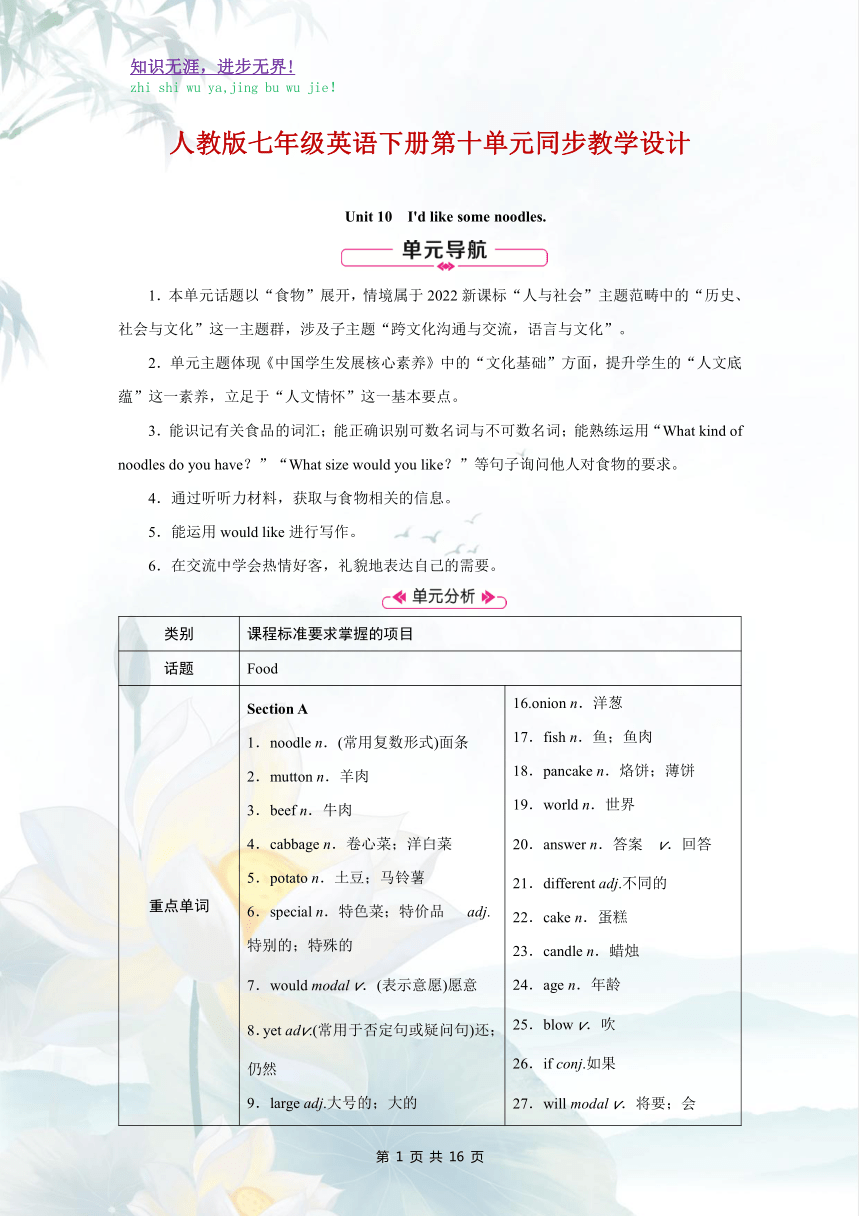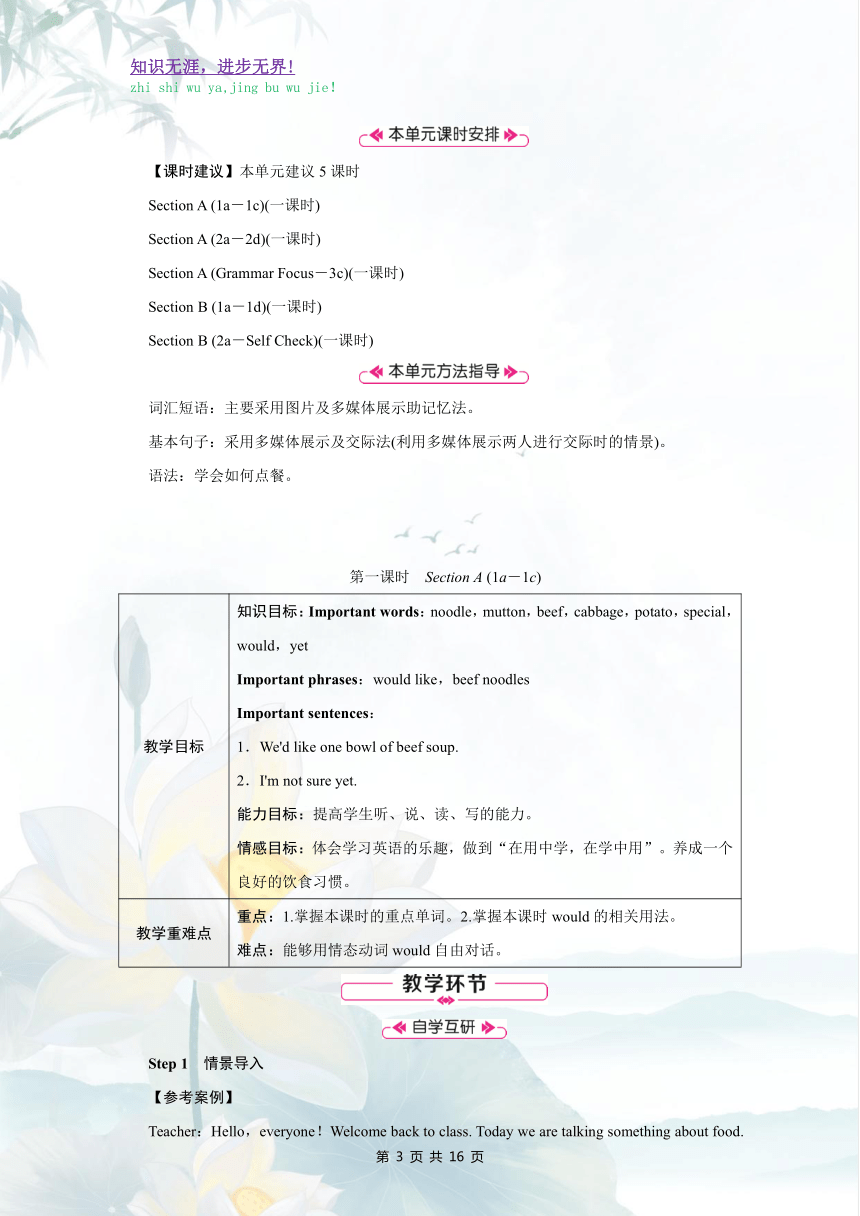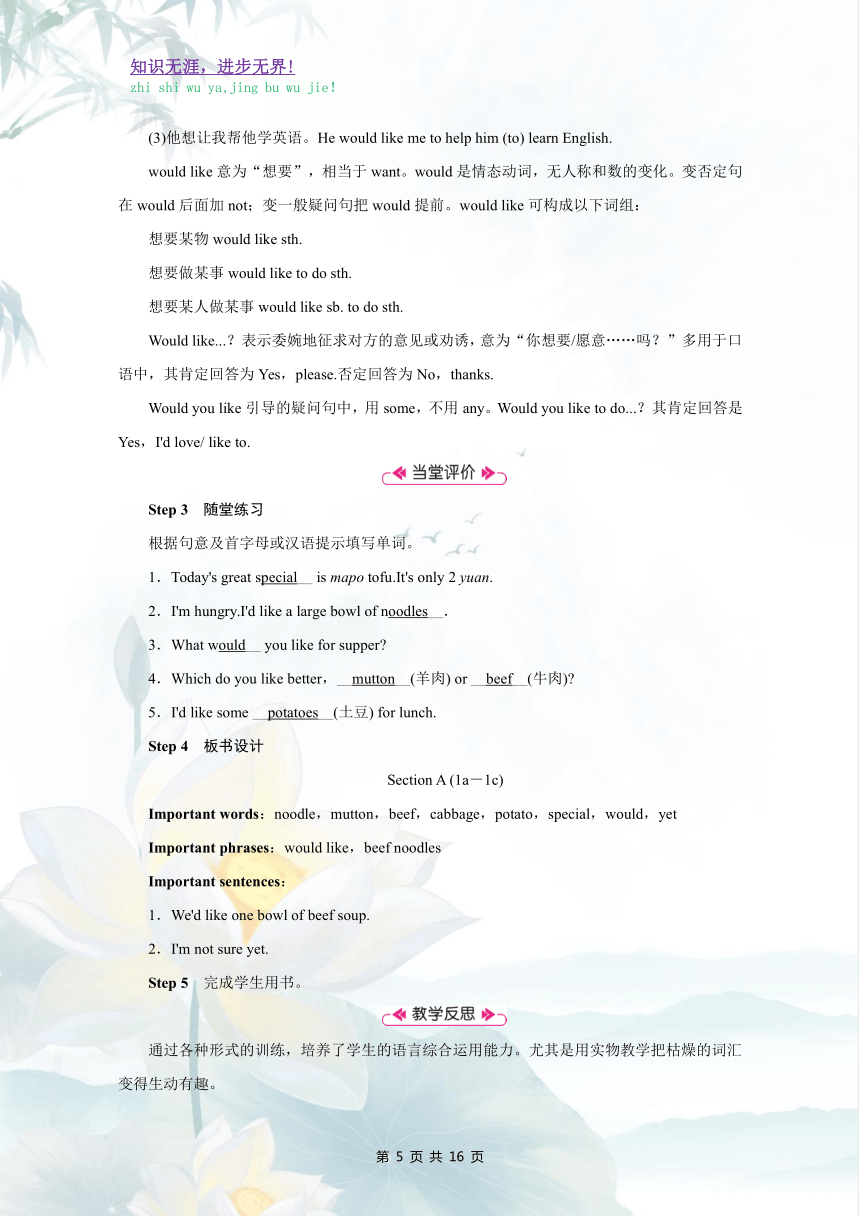人教版七年级英语下册Unit 10 I'd like some noodles. 同步教学设计(共5课时)
文档属性
| 名称 | 人教版七年级英语下册Unit 10 I'd like some noodles. 同步教学设计(共5课时) |  | |
| 格式 | docx | ||
| 文件大小 | 1.8MB | ||
| 资源类型 | 教案 | ||
| 版本资源 | 人教新目标(Go for it)版 | ||
| 科目 | 英语 | ||
| 更新时间 | 2024-05-06 08:50:32 | ||
图片预览





文档简介
!
人教版七年级英语下册第十单元同步教学设计
Unit 10 I'd like some noodles.
1.本单元话题以“食物”展开,情境属于2022新课标“人与社会”主题范畴中的“历史、社会与文化”这一主题群,涉及子主题“跨文化沟通与交流,语言与文化”。
2.单元主题体现《中国学生发展核心素养》中的“文化基础”方面,提升学生的“人文底蕴”这一素养,立足于“人文情怀”这一基本要点。
3.能识记有关食品的词汇;能正确识别可数名词与不可数名词;能熟练运用“What kind of noodles do you have?”“What size would you like?”等句子询问他人对食物的要求。
4.通过听听力材料,获取与食物相关的信息。
5.能运用would like进行写作。
6.在交流中学会热情好客,礼貌地表达自己的需要。
类别 课程标准要求掌握的项目
话题 Food
重点单词 Section A 1.noodle n.(常用复数形式)面条 2.mutton n.羊肉 3.beef n.牛肉 4.cabbage n.卷心菜;洋白菜 5.potato n.土豆;马铃薯 6.special n.特色菜;特价品 adj.特别的;特殊的 7.would modal v.(表示意愿)愿意 8.yet adv.(常用于否定句或疑问句)还;仍然 9.large adj.大号的;大的 10.order n.& v.点菜;命令 11.size n.大小;尺码 12.bowl n.碗 13.meat n.(可食用的)肉 Section B 14.dumpling n.饺子 15.porridge n.粥;面糊 16.onion n.洋葱 17.fish n.鱼;鱼肉 18.pancake n.烙饼;薄饼 19.world n.世界 20.answer n.答案 v.回答 21.different adj.不同的 22.cake n.蛋糕 23.candle n.蜡烛 24.age n.年龄 25.blow v.吹 26.if conj.如果 27.will modal v.将要;会 28.the UK n.英国 29.candy n.糖果 30.lucky adj.幸运的 31.popular adj.受欢迎的;普遍的 32.idea n.想法;主意
重点短语 Section A 1.would like(表示意愿)愿意;喜欢 2.take one's order点菜 3.one (large) bowl of…一(大)碗…… Section B 4.around the world世界各地 5.make a wish许愿 6.blow out吹灭 7.get popular受欢迎;流行 8.cut up切碎 9.bring good luck to…给……带来好运
续表
类别 课程标准要求掌握的项目
重点句型 1.—What kind of noodles would you like?你想吃什么样的面条? —I'd like beef noodles,please.我想要牛肉面。 2.—What size would you like?你喜欢多大碗的? —I'd like a small/medium/large bowl.我喜欢小碗/中碗/大碗。 3.—Would you like a large bowl?你想要大碗的吗? —Yes,please.是的。
单元语法 1.可数名词与不可数名词的区别。 2.情态动词would的用法和what引导的特殊疑问句。
知识目标 1.能掌握本单元重点单词及句型。 2.能掌握情态动词would的用法。 3.能掌握订餐或叫外卖等的用语。
能力目标 培养学生的听说读写能力。
情感目标 体会学习英语的乐趣,做到“在用中学”“在学中用”。养成一个良好的饮食习惯。
【课时建议】本单元建议5课时
Section A (1a-1c)(一课时)
Section A (2a-2d)(一课时)
Section A (Grammar Focus-3c)(一课时)
Section B (1a-1d)(一课时)
Section B (2a-Self Check)(一课时)
词汇短语:主要采用图片及多媒体展示助记忆法。
基本句子:采用多媒体展示及交际法(利用多媒体展示两人进行交际时的情景)。
语法:学会如何点餐。
第一课时 Section A (1a-1c)
教学目标 知识目标:Important words:noodle,mutton,beef,cabbage,potato,special,would,yet Important phrases:would like,beef noodles Important sentences: 1.We'd like one bowl of beef soup. 2.I'm not sure yet. 能力目标:提高学生听、说、读、写的能力。 情感目标:体会学习英语的乐趣,做到“在用中学,在学中用”。养成一个良好的饮食习惯。
教学重难点 重点:1.掌握本课时的重点单词。2.掌握本课时would的相关用法。 难点:能够用情态动词would自由对话。
Step 1 情景导入
【参考案例】
Teacher:Hello,everyone!Welcome back to class. Today we are talking something about food. First please name the drinks,vegetables,meat and fruit you know. Make a list of the nouns and write them down on the blackboard according to the countable nouns and uncountable nouns.
Such as:
Countable nouns:eggs,apples,pears,bananas,cakes,watermelons…
Uncountable nouns:milk,water,mutton,cola,beef…
Countable and uncountable nouns:ice cream,salad,chicken…
设计意图:通过复习归纳关于饮料、蔬菜、肉类与水果等名词导入本单元的话题,让学生能够正确区别可数名词与不可名词,为本单元的听、说、读、写训练作好铺垫。
Step 2 完成教材1a-1c的任务
【操作案例】
1.认真观察1a中的图片,完成1a的任务。
2.认真听录音,完成1b的任务。
3.大声朗读并背诵1a中的小对话,结对练习1a中的对话,最熟练的一组要到讲台上展示。
4.仿照1a中的小对话,先由师生之间进行口语训练,然后让同学们自己编写并表演对话,完成1c的任务。
设计意图:通过学习1a,让学生熟悉并掌握一些食品单词;通过学习1b,锻炼学生的听力及抓取关键信息的能力,掌握would like的用法;通过1c的训练,锻炼学生的口头表达能力,同时巩固所学的单词与句型。
知识点拨
1.some和any的用法
(1)牛肉面里有一些西红柿。There are some tomatoes in the beef noodles.
(2)羊肉面里没有洋白菜。There aren't any cabbages in the mutton noodles.
(3)我能问你一些问题吗?Can I ask you some questions
some意为“一些”,用在肯定句中,any用在否定句或一般疑问句中。some也可以用在委婉的一般疑问句中,表示希望得到对方的肯定答复。
2.would like 的用法
(1)他想吃些面条。He would like some noodles.
(2)你想和我打篮球吗?Would you like to play basketball with me
(3)他想让我帮他学英语。He would like me to help him (to) learn English.
would like意为“想要”,相当于want。would是情态动词,无人称和数的变化。变否定句在would后面加not;变一般疑问句把would提前。would like可构成以下词组:
想要某物would like sth.
想要做某事would like to do sth.
想要某人做某事would like sb. to do sth.
Would like...?表示委婉地征求对方的意见或劝诱,意为“你想要/愿意……吗?”多用于口语中,其肯定回答为Yes,please.否定回答为No,thanks.
Would you like引导的疑问句中,用some,不用any。Would you like to do...?其肯定回答是Yes,I'd love/ like to.
Step 3 随堂练习
根据句意及首字母或汉语提示填写单词。
1.Today's great special__ is mapo tofu.It's only 2 yuan.
2.I'm hungry.I'd like a large bowl of noodles__.
3.What would__ you like for supper
4.Which do you like better,__mutton__(羊肉) or __beef__(牛肉)
5.I'd like some __potatoes__(土豆) for lunch.
Step 4 板书设计
Section A (1a-1c)
Important words:noodle,mutton,beef,cabbage,potato,special,would,yet
Important phrases:would like,beef noodles
Important sentences:
1.We'd like one bowl of beef soup.
2.I'm not sure yet.
Step 5 完成学生用书。
通过各种形式的训练,培养了学生的语言综合运用能力。尤其是用实物教学把枯燥的词汇变得生动有趣。
第二课时 Section A (2a-2d)
教学目标 知识目标:Important words:large,order,size,bowl,tofu Important phrases:take one's order,one (large/medium/small) bowl of… Important sentences: 1.May I take your order 2.We'd like one bowl of beef soup. 能力目标:提高学生听、说、读、写的能力。 情感目标:体会学习英语的乐趣,做到“在用中学,在学中用”。养成一个良好的饮食习惯。
教学重难点 重点:1.掌握本课时的重点单词。2.掌握本课时would的相关用法。 难点:能够用情态动词would自由对话。
Step 1 情景导入
【参考案例】
Teacher:Do you like noodles?What kind of noodles do you like
Student 1:I like noodles very much.And I like beef noodles,and there are some vegetables in the noodles.
Teacher:What about you
Student 2:I don't like noodles with meat in them. I like tomato noodles.
设计意图:通过师生互动复习上节课的内容,并且为新课的学习打下了基础。
Step 2 完成教材2a-2c的任务
【操作案例】
1.认真听录音,完成2a的任务。
2.再听一遍录音,完成2b中的句子。
3.根据2a中的图片信息和听力材料,让学生结对谈论图片中的食品以及自己的喜好,完成2c的任务。并要求多个小组上台展示。
设计意图:通过听、说学习训练让学生掌握了解了要掌握的语言目标,学生的口语表达能力在这一环节得到提升。
Step 3 完成教材2d的任务
1.学生自读对话,根据对话内容完成下列句子。
(1)Sally would like some __vegetables__ in the beef soup.
(2)Sally wants one __large__ bowl of beef soup.
(3)Sally would like __one_large_bowl_of_beef_soup__,__one_gongbao_chicken__,__one_mapo_tofu_with_rice__.
2.分角色朗读2d中的对话内容,解释重点短语和句子并让多个小组上台展示,然后让学生大声朗读对话内容。
设计意图:通过对本单元所学的语言知识进行听说训练,不仅锻炼了学生的语言综合运用能力,还巩固了学生对本单元单词与重点句型的学习、识记和运用。
知识点拨
1.fish n.鱼;v.钓鱼
(1)表示条数或数量时,单复数同形。
如:There are three fish in the bowl. 鱼缸里有三条鱼。
Would you like go fishing with me 你想和我去钓鱼吗?
(2)表示不同种类的鱼时,加 es。
如:There are three kinds of fishes in the bowl. 鱼缸里有三种鱼。
(3)表示鱼肉时,是不可数名词。
如:I like fish. 我喜欢鱼肉。
2.large adj. 大的; 宽大的。
(1)侧重面积体积之大,large=big,反义词small。
如:China is a large country.中国是个大国。(强调面积)
(2)big 侧重体积之大,还表示人的高大和长大,反义词little。
如:China is a big country. 中国是个大国。(强调实力)
(3)great 伟大的,可指抽象的程度。
如:China is a great country. 中国是个伟大的国家。(抽象意义上的伟大)
Step 4 随堂练习
根据句意及首字母或汉语提示填写单词。
1.What size__ of shirt would you like,small,medium or large
2.May I take your order__ now
3.I want one large bowl__ of noodles.
4.I'd like some __tofu__(豆腐),please.
Step 5 板书设计
Section A (2a-2d)
Important words:large,order,size,bowl,tofu
Important phrases:take one's order,one (large/medium/small) bowl of…
Important sentences:
1.May I take your order
2.We'd like one bowl of beef soup.
Step 6 完成学生用书。
通过各种形式的训练,培养了学生的语言综合运用能力。尤其是用实物教学把枯燥的词汇变得生动有趣。
第三课时 Section A (Grammar Focus-3c)
教学目标 知识目标:Important word:meat Important phrases:beef noodles,potato salad Important sentences: 1.—What kind of noodles would you like —I'd like beef noodles,please. 2.—What size would you like —I'd like a large bowl,please. 3.—Would you like a large bowl —Yes,please. 能力目标:1.通过组句训练,强化本单元重点知识的学习和突破语法难点。2.通过开放性的口语活动,能够在真实的语境中使用目标词汇和句型。 情感目标:体会学习英语的乐趣,做到“在用中学”“在学中用”。养成一个良好的饮食习惯。
教学重难点 重点:复习巩固Section A 部分所学的生词和词组,达到熟练运用情态动词表达自己需求的程度。 难点:通过分角色扮演熟练掌握情态动词的用法。
Step 1 情景导入
【参考案例】
Teacher:Look at the three pictures.Please answer the questions below.
Can you see three bowls
What are in them
Do you like noodles
Can you find the differences among the three bowls of noodles
What size bowl of noodles would you like—small,medium or large
设计意图:通过情景导入,复习巩固上节课所学习的新单词和重点句型,进一步区别可数名词和不可数名词,并灵活运用于听、说、读、写训练之中。同时结合本单元的重点语法知识对学生进行听说训练。
Step 2 畅通Grammar Focus回顾语法重点
【操作案例】
1.让学生分男、女两组朗读Grammar Focus中的内容。
2.让同学们背诵Grammar Focus中的内容。
设计意图:通过语法基础知识的训练,让学生能够进一步掌握would like的用法,熟悉就餐话题的单词与一些基本句型,为本单元听、说、读、写的训练做好铺垫。
Step 3 完成教材3a-3c的任务
【操作案例】
1.让学生运用本单元所学的语言知识,完成3a的任务。
2.让学生分角色朗读3a中所提的问题与回答,巩固本单元的语法基础知识。
3.根据括号里的提示词,完成3b的任务。
4.分小组活动,完成3c的任务。
设计意图:通过完成教材3a-3c的任务,进一步巩固语法基础知识,并运用所学的语言基础知识,培养学生运用语言的能力。让学生在实际操练中领会并掌握语法基础知识,老师在该环节中起到引导作用。
知识点拨
1.order的用法
(1)order n. 订单
如:May I take your order now 你们可以点菜了吗?
(2)v.命令
order sb. to do sth.命令某人做某事
如:The doctor ordered you to be quiet. 医生嘱咐你要保持安静。
(3)order sb. sth. = order sth. for sb.为某人订购某物
如:My father ordered a new desk for me. 父亲为我订购了一个新写字台。
(4)take an order 接受…… 的订购
2.meat (食用)肉类
cow牛,beef 牛肉 /chicken 鸡,chicken 鸡肉/goat山羊,sheep绵羊,mutton 羊肉/pig猪,pork猪肉
Step 4 随堂练习
根据句意及汉语提示填写单词或短语。
1.What kind of __meat__(肉) do you like better,mutton or beef
2.I'd like __a_large_bowl_of__(一大碗) noodles.
3.—What kind of noodles would you like
—__Beef_noodles__(牛肉面).
4.Would you like __potato_salad__(土豆沙拉) or fruit salad
Step 5 板书设计
Section A (Grammar Focus-3c)
Important word:meat
Important phrases:beef noodles,potato salad
Important sentences:
1.—What kind of noodles would you like
—I'd like beef noodles,please.
2.—What size would you like
—I'd like a large bowl,please.
3.—Would you like a large bowl
—Yes,please.
Step 6 完成学生用书。
本节课通过 Grammar Focus让学生清晰回顾本堂课的知识结构,检测学生是否能基本运用本堂课的目标语言,体现对学生的可持续性评价。
第四课时 Section B (1a-1d)
教学目标 知识目标:Important words:dumpling,porridge,onion,fish,pancake Important phrase:orange juice 能力目标:1.通过听录音前的词汇分类与听录音时聚焦关键信息,学生能掌握听力策略。2.通过听录音后深度挖掘听力信息任务的设置和文本再构,学生能进一步思考并表达观点,提高学生听力和口语技能。 情感目标:养成一个良好的饮食习惯。
教学重难点 重点:1.熟练使用重点词汇、短语和句型。2.进行听力训练,提高综合听说能力。3.使用本单元的目标句型,拓展听力内容进行交际。 难点:使用本单元的目标句型,进行听力内容拓展交际。
Step 1 情景导入
【参考案例】
Teacher:Last class we learned some words about food,and we have got to know how to order food.This class we'll learn some more words and phrases about food.Look at the new words on the board and read after me:onion,dumplings,porridge,soup,orange juice,green tea.
设计意图:通过复习和巩固单词及重要句型,进一步拓展学生的词汇量,让学生掌握并灵活运用本单元所学的语言基础知识,让学生在轻松的氛围中接收到关于教学目标的信息。
Step 2 完成教材1a-1d的任务
【操作案例】
1.让学生将图片中的食品与相应的单词搭配起来,完成教材1a的任务。
2.根据自己对1a图片中食品的喜好,完成1b的任务。
3.听录音,完成1c的任务。
4.再听一遍录音,完成1d的任务。
5.对听力材料的重点词组或句子进行讲解,然后让全班学生分角色熟读听力材料,还可邀请几组学生进行分角色朗读表演。
设计意图:通过听、说训练让学生能够正确区别可数名词与不可数名词,掌握一些常见食品的名词,灵活运用订购食品时需要提供或填写的一些基本信息,巩固目标语言。
知识点拨
1.would like 想要 = want
如:I'd like some noodles.我想要一些面条。
2.Would you like …?用于委婉的提出建议,或征求对方意见。
肯定答语:Yes,please. Yes,I'd like/love to.
否定答语:No,thanks.
如:—Would you like some tea?你想要些茶?
—Yes, please. /No, thanks.是的,谢谢。/不,谢谢。
—Would you like to go swimming with us?你想和我们一起去游泳吗?
—Yes, I'd love to.是的,我想去。
Step 3 随堂练习
根据句意及汉语提示填写单词或短语。
1.Chinese people usually eat __dumplings__(饺子) on the Spring Festival(春节).
2.I'd like a glass of __orange_juice__(橙汁).
3.And we don't like __onions__(洋葱) or potatoes.
4.My parents and I like __fish__(鱼) very much.
5.My grandmother eats __a_large_bowl_of_porridge__(一大碗粥) every morning.
Step 4 板书设计
Section B (1a-1d)
Important words:dumpling,porridge,onion,fish,pancake
Important phrase:orange juice
Step 5 完成学生用书。
本节课通过听录音前的词汇分类与听录音时聚焦关键信息,学生能掌握该听力策略, 通过听录音后深度挖掘听力信息任务的设置和文本再构,学生能进一步思考并表达观点,提高了学生听力和口语技能。
第五课时 Section B (2a-Self Check)
教学目标 知识目标:Important words:world,answer,different,cake,candle,age,blow,if,will,the UK,candy,lucky,popular,idea Important phrases:around the world,make a wish,blow out,get popular,cut up,bring good luck to… Important sentences: 1.The number of candles is the person's age. 2.In China,it is getting popular to have cake on your birthday. 能力目标:能从阅读中获得不同国家过生日的不同方式的相关信息。 情感目标:尊重不同国家的文化习俗。
教学重难点 重点:掌握阅读策略,培养阅读能力。 难点:通过阅读训练,巩固现在完成时的用法。
Step 1 情景导入
【参考案例】
Teacher:Now,please work in pairs.One person is the waiter,and the other one is the customer.Let's practice the conversation,imagining you are in a restaurant(each student can be both the waiter and the customer).
设计意图:通过服务员与顾客之间的小组对话导入新课,复习上节课所学的重点单词、句子与语法,灵活运用本单元的语言知识编写并表演对话,激发学生的学习兴趣,调动学生的学习积极性与主动性。
Step 2 完成教材2a-2c的任务
【操作案例】
1.谈论过生日时,常做什么?常吃什么?完成2a的任务。
2.阅读2b中的材料,并完成2b的任务。
3.再次阅读2b中的材料,并完成2c的任务。
4.对重点词组或句子进行讲解,让学生大声朗读阅读材料。
设计意图:通过本单元话题的阅读训练,扩大学生的词汇量,拓展学生的知识面,培养学生的阅读能力,提高学生的阅读水平与技巧。
Step 3 完成教材3a-3c的任务
【操作案例】
1.阅读广告,掌握其大意,然后从方框中选择恰当的单词填入短文,完成3a的任务。
2.学生自由发挥,完成3b的任务。
3.模仿3a的广告写作,结合3b的任务,让学生为自己的餐馆写一份广告,完成3c的任务。
设计意图:通过阅读与写作训练相结合,进一步让学生巩固本单元所学的语言知识,提高学生的阅读能力,让学生掌握餐馆广告的写作格式和基本内容,提高学生的写作能力。
Step 4 完成教材Self Check的任务
【操作案例】
1.根据食品名词的分类,完成第一题。
2.正确使用there be结构,完成第二题。
3.结合本单元所学的就餐话题的语言知识,完成第三题。
4.邀请1-2组学生展示第三题的对话。
设计意图:通过各种题型的练习加强对新知识的巩固与拓展,并对本单元所学的语言知识进行归纳、总结,并灵活运用于听、说、读、写的各项训练中;灵活运用本单元的语言知识要点完成口语表达,为整个单元的学习画上一个圆满的句号。
知识点拨
1.What size…would you like?常用来询问某人想要物体的尺寸大小。
如:What size cake would you like?你想要多大尺寸的蛋糕?
What size shoes does your brother wear?你哥哥穿多大码的鞋子?
2.be动词+钱数+for+商品数量,表示商品价格。
如:These CDs are 10 yuan for 3.这些CD 10元3个。
The apples are 3 yuan for 5.这些苹果3元5个。
Step 5 随堂练习
根据句意及首字母提示填写单词。
1.Lucy is from the USA.Jim is from the UK.They are from different__ countries.
2.We often have cakes__ on our birthday in China.
3.The number of candles__ is the person's age.
4.If__ you have nothing to do this afternoon,let's play basketball.
5.He is very lucky__ to have a special birthday party.
6.It is very popular__ to wear this kind of skirt this year.
Step 6 板书设计
Section B (2a-Self Check)
Important words:world,answer,different,cake,candle,age,blow,if,will,the UK,candy,lucky,popular,idea
Important phrases:around the world,make a wish,blow out,get popular,cut up,bring good luck to…
Important sentences:
1.The number of candles is the person's age.
2.In China,it is getting popular to have cakes on your birthday.
Step 7 完成学生用书。
本课时以师生问答的方式导入新内容话题,贴近学生实际生活,激发学习兴趣;读写训练相结合,着重锻炼学生的阅读能力和写作能力。
人教版七年级英语下册第十单元同步教学设计
Unit 10 I'd like some noodles.
1.本单元话题以“食物”展开,情境属于2022新课标“人与社会”主题范畴中的“历史、社会与文化”这一主题群,涉及子主题“跨文化沟通与交流,语言与文化”。
2.单元主题体现《中国学生发展核心素养》中的“文化基础”方面,提升学生的“人文底蕴”这一素养,立足于“人文情怀”这一基本要点。
3.能识记有关食品的词汇;能正确识别可数名词与不可数名词;能熟练运用“What kind of noodles do you have?”“What size would you like?”等句子询问他人对食物的要求。
4.通过听听力材料,获取与食物相关的信息。
5.能运用would like进行写作。
6.在交流中学会热情好客,礼貌地表达自己的需要。
类别 课程标准要求掌握的项目
话题 Food
重点单词 Section A 1.noodle n.(常用复数形式)面条 2.mutton n.羊肉 3.beef n.牛肉 4.cabbage n.卷心菜;洋白菜 5.potato n.土豆;马铃薯 6.special n.特色菜;特价品 adj.特别的;特殊的 7.would modal v.(表示意愿)愿意 8.yet adv.(常用于否定句或疑问句)还;仍然 9.large adj.大号的;大的 10.order n.& v.点菜;命令 11.size n.大小;尺码 12.bowl n.碗 13.meat n.(可食用的)肉 Section B 14.dumpling n.饺子 15.porridge n.粥;面糊 16.onion n.洋葱 17.fish n.鱼;鱼肉 18.pancake n.烙饼;薄饼 19.world n.世界 20.answer n.答案 v.回答 21.different adj.不同的 22.cake n.蛋糕 23.candle n.蜡烛 24.age n.年龄 25.blow v.吹 26.if conj.如果 27.will modal v.将要;会 28.the UK n.英国 29.candy n.糖果 30.lucky adj.幸运的 31.popular adj.受欢迎的;普遍的 32.idea n.想法;主意
重点短语 Section A 1.would like(表示意愿)愿意;喜欢 2.take one's order点菜 3.one (large) bowl of…一(大)碗…… Section B 4.around the world世界各地 5.make a wish许愿 6.blow out吹灭 7.get popular受欢迎;流行 8.cut up切碎 9.bring good luck to…给……带来好运
续表
类别 课程标准要求掌握的项目
重点句型 1.—What kind of noodles would you like?你想吃什么样的面条? —I'd like beef noodles,please.我想要牛肉面。 2.—What size would you like?你喜欢多大碗的? —I'd like a small/medium/large bowl.我喜欢小碗/中碗/大碗。 3.—Would you like a large bowl?你想要大碗的吗? —Yes,please.是的。
单元语法 1.可数名词与不可数名词的区别。 2.情态动词would的用法和what引导的特殊疑问句。
知识目标 1.能掌握本单元重点单词及句型。 2.能掌握情态动词would的用法。 3.能掌握订餐或叫外卖等的用语。
能力目标 培养学生的听说读写能力。
情感目标 体会学习英语的乐趣,做到“在用中学”“在学中用”。养成一个良好的饮食习惯。
【课时建议】本单元建议5课时
Section A (1a-1c)(一课时)
Section A (2a-2d)(一课时)
Section A (Grammar Focus-3c)(一课时)
Section B (1a-1d)(一课时)
Section B (2a-Self Check)(一课时)
词汇短语:主要采用图片及多媒体展示助记忆法。
基本句子:采用多媒体展示及交际法(利用多媒体展示两人进行交际时的情景)。
语法:学会如何点餐。
第一课时 Section A (1a-1c)
教学目标 知识目标:Important words:noodle,mutton,beef,cabbage,potato,special,would,yet Important phrases:would like,beef noodles Important sentences: 1.We'd like one bowl of beef soup. 2.I'm not sure yet. 能力目标:提高学生听、说、读、写的能力。 情感目标:体会学习英语的乐趣,做到“在用中学,在学中用”。养成一个良好的饮食习惯。
教学重难点 重点:1.掌握本课时的重点单词。2.掌握本课时would的相关用法。 难点:能够用情态动词would自由对话。
Step 1 情景导入
【参考案例】
Teacher:Hello,everyone!Welcome back to class. Today we are talking something about food. First please name the drinks,vegetables,meat and fruit you know. Make a list of the nouns and write them down on the blackboard according to the countable nouns and uncountable nouns.
Such as:
Countable nouns:eggs,apples,pears,bananas,cakes,watermelons…
Uncountable nouns:milk,water,mutton,cola,beef…
Countable and uncountable nouns:ice cream,salad,chicken…
设计意图:通过复习归纳关于饮料、蔬菜、肉类与水果等名词导入本单元的话题,让学生能够正确区别可数名词与不可名词,为本单元的听、说、读、写训练作好铺垫。
Step 2 完成教材1a-1c的任务
【操作案例】
1.认真观察1a中的图片,完成1a的任务。
2.认真听录音,完成1b的任务。
3.大声朗读并背诵1a中的小对话,结对练习1a中的对话,最熟练的一组要到讲台上展示。
4.仿照1a中的小对话,先由师生之间进行口语训练,然后让同学们自己编写并表演对话,完成1c的任务。
设计意图:通过学习1a,让学生熟悉并掌握一些食品单词;通过学习1b,锻炼学生的听力及抓取关键信息的能力,掌握would like的用法;通过1c的训练,锻炼学生的口头表达能力,同时巩固所学的单词与句型。
知识点拨
1.some和any的用法
(1)牛肉面里有一些西红柿。There are some tomatoes in the beef noodles.
(2)羊肉面里没有洋白菜。There aren't any cabbages in the mutton noodles.
(3)我能问你一些问题吗?Can I ask you some questions
some意为“一些”,用在肯定句中,any用在否定句或一般疑问句中。some也可以用在委婉的一般疑问句中,表示希望得到对方的肯定答复。
2.would like 的用法
(1)他想吃些面条。He would like some noodles.
(2)你想和我打篮球吗?Would you like to play basketball with me
(3)他想让我帮他学英语。He would like me to help him (to) learn English.
would like意为“想要”,相当于want。would是情态动词,无人称和数的变化。变否定句在would后面加not;变一般疑问句把would提前。would like可构成以下词组:
想要某物would like sth.
想要做某事would like to do sth.
想要某人做某事would like sb. to do sth.
Would like...?表示委婉地征求对方的意见或劝诱,意为“你想要/愿意……吗?”多用于口语中,其肯定回答为Yes,please.否定回答为No,thanks.
Would you like引导的疑问句中,用some,不用any。Would you like to do...?其肯定回答是Yes,I'd love/ like to.
Step 3 随堂练习
根据句意及首字母或汉语提示填写单词。
1.Today's great special__ is mapo tofu.It's only 2 yuan.
2.I'm hungry.I'd like a large bowl of noodles__.
3.What would__ you like for supper
4.Which do you like better,__mutton__(羊肉) or __beef__(牛肉)
5.I'd like some __potatoes__(土豆) for lunch.
Step 4 板书设计
Section A (1a-1c)
Important words:noodle,mutton,beef,cabbage,potato,special,would,yet
Important phrases:would like,beef noodles
Important sentences:
1.We'd like one bowl of beef soup.
2.I'm not sure yet.
Step 5 完成学生用书。
通过各种形式的训练,培养了学生的语言综合运用能力。尤其是用实物教学把枯燥的词汇变得生动有趣。
第二课时 Section A (2a-2d)
教学目标 知识目标:Important words:large,order,size,bowl,tofu Important phrases:take one's order,one (large/medium/small) bowl of… Important sentences: 1.May I take your order 2.We'd like one bowl of beef soup. 能力目标:提高学生听、说、读、写的能力。 情感目标:体会学习英语的乐趣,做到“在用中学,在学中用”。养成一个良好的饮食习惯。
教学重难点 重点:1.掌握本课时的重点单词。2.掌握本课时would的相关用法。 难点:能够用情态动词would自由对话。
Step 1 情景导入
【参考案例】
Teacher:Do you like noodles?What kind of noodles do you like
Student 1:I like noodles very much.And I like beef noodles,and there are some vegetables in the noodles.
Teacher:What about you
Student 2:I don't like noodles with meat in them. I like tomato noodles.
设计意图:通过师生互动复习上节课的内容,并且为新课的学习打下了基础。
Step 2 完成教材2a-2c的任务
【操作案例】
1.认真听录音,完成2a的任务。
2.再听一遍录音,完成2b中的句子。
3.根据2a中的图片信息和听力材料,让学生结对谈论图片中的食品以及自己的喜好,完成2c的任务。并要求多个小组上台展示。
设计意图:通过听、说学习训练让学生掌握了解了要掌握的语言目标,学生的口语表达能力在这一环节得到提升。
Step 3 完成教材2d的任务
1.学生自读对话,根据对话内容完成下列句子。
(1)Sally would like some __vegetables__ in the beef soup.
(2)Sally wants one __large__ bowl of beef soup.
(3)Sally would like __one_large_bowl_of_beef_soup__,__one_gongbao_chicken__,__one_mapo_tofu_with_rice__.
2.分角色朗读2d中的对话内容,解释重点短语和句子并让多个小组上台展示,然后让学生大声朗读对话内容。
设计意图:通过对本单元所学的语言知识进行听说训练,不仅锻炼了学生的语言综合运用能力,还巩固了学生对本单元单词与重点句型的学习、识记和运用。
知识点拨
1.fish n.鱼;v.钓鱼
(1)表示条数或数量时,单复数同形。
如:There are three fish in the bowl. 鱼缸里有三条鱼。
Would you like go fishing with me 你想和我去钓鱼吗?
(2)表示不同种类的鱼时,加 es。
如:There are three kinds of fishes in the bowl. 鱼缸里有三种鱼。
(3)表示鱼肉时,是不可数名词。
如:I like fish. 我喜欢鱼肉。
2.large adj. 大的; 宽大的。
(1)侧重面积体积之大,large=big,反义词small。
如:China is a large country.中国是个大国。(强调面积)
(2)big 侧重体积之大,还表示人的高大和长大,反义词little。
如:China is a big country. 中国是个大国。(强调实力)
(3)great 伟大的,可指抽象的程度。
如:China is a great country. 中国是个伟大的国家。(抽象意义上的伟大)
Step 4 随堂练习
根据句意及首字母或汉语提示填写单词。
1.What size__ of shirt would you like,small,medium or large
2.May I take your order__ now
3.I want one large bowl__ of noodles.
4.I'd like some __tofu__(豆腐),please.
Step 5 板书设计
Section A (2a-2d)
Important words:large,order,size,bowl,tofu
Important phrases:take one's order,one (large/medium/small) bowl of…
Important sentences:
1.May I take your order
2.We'd like one bowl of beef soup.
Step 6 完成学生用书。
通过各种形式的训练,培养了学生的语言综合运用能力。尤其是用实物教学把枯燥的词汇变得生动有趣。
第三课时 Section A (Grammar Focus-3c)
教学目标 知识目标:Important word:meat Important phrases:beef noodles,potato salad Important sentences: 1.—What kind of noodles would you like —I'd like beef noodles,please. 2.—What size would you like —I'd like a large bowl,please. 3.—Would you like a large bowl —Yes,please. 能力目标:1.通过组句训练,强化本单元重点知识的学习和突破语法难点。2.通过开放性的口语活动,能够在真实的语境中使用目标词汇和句型。 情感目标:体会学习英语的乐趣,做到“在用中学”“在学中用”。养成一个良好的饮食习惯。
教学重难点 重点:复习巩固Section A 部分所学的生词和词组,达到熟练运用情态动词表达自己需求的程度。 难点:通过分角色扮演熟练掌握情态动词的用法。
Step 1 情景导入
【参考案例】
Teacher:Look at the three pictures.Please answer the questions below.
Can you see three bowls
What are in them
Do you like noodles
Can you find the differences among the three bowls of noodles
What size bowl of noodles would you like—small,medium or large
设计意图:通过情景导入,复习巩固上节课所学习的新单词和重点句型,进一步区别可数名词和不可数名词,并灵活运用于听、说、读、写训练之中。同时结合本单元的重点语法知识对学生进行听说训练。
Step 2 畅通Grammar Focus回顾语法重点
【操作案例】
1.让学生分男、女两组朗读Grammar Focus中的内容。
2.让同学们背诵Grammar Focus中的内容。
设计意图:通过语法基础知识的训练,让学生能够进一步掌握would like的用法,熟悉就餐话题的单词与一些基本句型,为本单元听、说、读、写的训练做好铺垫。
Step 3 完成教材3a-3c的任务
【操作案例】
1.让学生运用本单元所学的语言知识,完成3a的任务。
2.让学生分角色朗读3a中所提的问题与回答,巩固本单元的语法基础知识。
3.根据括号里的提示词,完成3b的任务。
4.分小组活动,完成3c的任务。
设计意图:通过完成教材3a-3c的任务,进一步巩固语法基础知识,并运用所学的语言基础知识,培养学生运用语言的能力。让学生在实际操练中领会并掌握语法基础知识,老师在该环节中起到引导作用。
知识点拨
1.order的用法
(1)order n. 订单
如:May I take your order now 你们可以点菜了吗?
(2)v.命令
order sb. to do sth.命令某人做某事
如:The doctor ordered you to be quiet. 医生嘱咐你要保持安静。
(3)order sb. sth. = order sth. for sb.为某人订购某物
如:My father ordered a new desk for me. 父亲为我订购了一个新写字台。
(4)take an order 接受…… 的订购
2.meat (食用)肉类
cow牛,beef 牛肉 /chicken 鸡,chicken 鸡肉/goat山羊,sheep绵羊,mutton 羊肉/pig猪,pork猪肉
Step 4 随堂练习
根据句意及汉语提示填写单词或短语。
1.What kind of __meat__(肉) do you like better,mutton or beef
2.I'd like __a_large_bowl_of__(一大碗) noodles.
3.—What kind of noodles would you like
—__Beef_noodles__(牛肉面).
4.Would you like __potato_salad__(土豆沙拉) or fruit salad
Step 5 板书设计
Section A (Grammar Focus-3c)
Important word:meat
Important phrases:beef noodles,potato salad
Important sentences:
1.—What kind of noodles would you like
—I'd like beef noodles,please.
2.—What size would you like
—I'd like a large bowl,please.
3.—Would you like a large bowl
—Yes,please.
Step 6 完成学生用书。
本节课通过 Grammar Focus让学生清晰回顾本堂课的知识结构,检测学生是否能基本运用本堂课的目标语言,体现对学生的可持续性评价。
第四课时 Section B (1a-1d)
教学目标 知识目标:Important words:dumpling,porridge,onion,fish,pancake Important phrase:orange juice 能力目标:1.通过听录音前的词汇分类与听录音时聚焦关键信息,学生能掌握听力策略。2.通过听录音后深度挖掘听力信息任务的设置和文本再构,学生能进一步思考并表达观点,提高学生听力和口语技能。 情感目标:养成一个良好的饮食习惯。
教学重难点 重点:1.熟练使用重点词汇、短语和句型。2.进行听力训练,提高综合听说能力。3.使用本单元的目标句型,拓展听力内容进行交际。 难点:使用本单元的目标句型,进行听力内容拓展交际。
Step 1 情景导入
【参考案例】
Teacher:Last class we learned some words about food,and we have got to know how to order food.This class we'll learn some more words and phrases about food.Look at the new words on the board and read after me:onion,dumplings,porridge,soup,orange juice,green tea.
设计意图:通过复习和巩固单词及重要句型,进一步拓展学生的词汇量,让学生掌握并灵活运用本单元所学的语言基础知识,让学生在轻松的氛围中接收到关于教学目标的信息。
Step 2 完成教材1a-1d的任务
【操作案例】
1.让学生将图片中的食品与相应的单词搭配起来,完成教材1a的任务。
2.根据自己对1a图片中食品的喜好,完成1b的任务。
3.听录音,完成1c的任务。
4.再听一遍录音,完成1d的任务。
5.对听力材料的重点词组或句子进行讲解,然后让全班学生分角色熟读听力材料,还可邀请几组学生进行分角色朗读表演。
设计意图:通过听、说训练让学生能够正确区别可数名词与不可数名词,掌握一些常见食品的名词,灵活运用订购食品时需要提供或填写的一些基本信息,巩固目标语言。
知识点拨
1.would like 想要 = want
如:I'd like some noodles.我想要一些面条。
2.Would you like …?用于委婉的提出建议,或征求对方意见。
肯定答语:Yes,please. Yes,I'd like/love to.
否定答语:No,thanks.
如:—Would you like some tea?你想要些茶?
—Yes, please. /No, thanks.是的,谢谢。/不,谢谢。
—Would you like to go swimming with us?你想和我们一起去游泳吗?
—Yes, I'd love to.是的,我想去。
Step 3 随堂练习
根据句意及汉语提示填写单词或短语。
1.Chinese people usually eat __dumplings__(饺子) on the Spring Festival(春节).
2.I'd like a glass of __orange_juice__(橙汁).
3.And we don't like __onions__(洋葱) or potatoes.
4.My parents and I like __fish__(鱼) very much.
5.My grandmother eats __a_large_bowl_of_porridge__(一大碗粥) every morning.
Step 4 板书设计
Section B (1a-1d)
Important words:dumpling,porridge,onion,fish,pancake
Important phrase:orange juice
Step 5 完成学生用书。
本节课通过听录音前的词汇分类与听录音时聚焦关键信息,学生能掌握该听力策略, 通过听录音后深度挖掘听力信息任务的设置和文本再构,学生能进一步思考并表达观点,提高了学生听力和口语技能。
第五课时 Section B (2a-Self Check)
教学目标 知识目标:Important words:world,answer,different,cake,candle,age,blow,if,will,the UK,candy,lucky,popular,idea Important phrases:around the world,make a wish,blow out,get popular,cut up,bring good luck to… Important sentences: 1.The number of candles is the person's age. 2.In China,it is getting popular to have cake on your birthday. 能力目标:能从阅读中获得不同国家过生日的不同方式的相关信息。 情感目标:尊重不同国家的文化习俗。
教学重难点 重点:掌握阅读策略,培养阅读能力。 难点:通过阅读训练,巩固现在完成时的用法。
Step 1 情景导入
【参考案例】
Teacher:Now,please work in pairs.One person is the waiter,and the other one is the customer.Let's practice the conversation,imagining you are in a restaurant(each student can be both the waiter and the customer).
设计意图:通过服务员与顾客之间的小组对话导入新课,复习上节课所学的重点单词、句子与语法,灵活运用本单元的语言知识编写并表演对话,激发学生的学习兴趣,调动学生的学习积极性与主动性。
Step 2 完成教材2a-2c的任务
【操作案例】
1.谈论过生日时,常做什么?常吃什么?完成2a的任务。
2.阅读2b中的材料,并完成2b的任务。
3.再次阅读2b中的材料,并完成2c的任务。
4.对重点词组或句子进行讲解,让学生大声朗读阅读材料。
设计意图:通过本单元话题的阅读训练,扩大学生的词汇量,拓展学生的知识面,培养学生的阅读能力,提高学生的阅读水平与技巧。
Step 3 完成教材3a-3c的任务
【操作案例】
1.阅读广告,掌握其大意,然后从方框中选择恰当的单词填入短文,完成3a的任务。
2.学生自由发挥,完成3b的任务。
3.模仿3a的广告写作,结合3b的任务,让学生为自己的餐馆写一份广告,完成3c的任务。
设计意图:通过阅读与写作训练相结合,进一步让学生巩固本单元所学的语言知识,提高学生的阅读能力,让学生掌握餐馆广告的写作格式和基本内容,提高学生的写作能力。
Step 4 完成教材Self Check的任务
【操作案例】
1.根据食品名词的分类,完成第一题。
2.正确使用there be结构,完成第二题。
3.结合本单元所学的就餐话题的语言知识,完成第三题。
4.邀请1-2组学生展示第三题的对话。
设计意图:通过各种题型的练习加强对新知识的巩固与拓展,并对本单元所学的语言知识进行归纳、总结,并灵活运用于听、说、读、写的各项训练中;灵活运用本单元的语言知识要点完成口语表达,为整个单元的学习画上一个圆满的句号。
知识点拨
1.What size…would you like?常用来询问某人想要物体的尺寸大小。
如:What size cake would you like?你想要多大尺寸的蛋糕?
What size shoes does your brother wear?你哥哥穿多大码的鞋子?
2.be动词+钱数+for+商品数量,表示商品价格。
如:These CDs are 10 yuan for 3.这些CD 10元3个。
The apples are 3 yuan for 5.这些苹果3元5个。
Step 5 随堂练习
根据句意及首字母提示填写单词。
1.Lucy is from the USA.Jim is from the UK.They are from different__ countries.
2.We often have cakes__ on our birthday in China.
3.The number of candles__ is the person's age.
4.If__ you have nothing to do this afternoon,let's play basketball.
5.He is very lucky__ to have a special birthday party.
6.It is very popular__ to wear this kind of skirt this year.
Step 6 板书设计
Section B (2a-Self Check)
Important words:world,answer,different,cake,candle,age,blow,if,will,the UK,candy,lucky,popular,idea
Important phrases:around the world,make a wish,blow out,get popular,cut up,bring good luck to…
Important sentences:
1.The number of candles is the person's age.
2.In China,it is getting popular to have cakes on your birthday.
Step 7 完成学生用书。
本课时以师生问答的方式导入新内容话题,贴近学生实际生活,激发学习兴趣;读写训练相结合,着重锻炼学生的阅读能力和写作能力。
同课章节目录
- Unit 1 Can you play the guitar?
- Section A
- Section B
- Unit 2 What time do you go to school?
- Section A
- Section B
- Unit 3 How do you get to school?
- Section A
- Section B
- Unit 4 Don't eat in class.
- Section A
- Section B
- Unit 5 Why do you like pandas?
- Section A
- Section B
- Unit 6 I'm watching TV.
- Section A
- Section B
- Review of Units 1-6
- Unit 7 It's raining!
- Section A
- Section B
- Unit 8 Is there a post office near here?
- Section A
- Section B
- Unit 9 What does he look like?
- Section A
- Section B
- Unit 10 I'd like some noodles.
- Section A
- Section B
- Unit 11 How was your school trip?
- Section A
- Section B
- Unit 12 What did you do last weekend?
- Section A
- Section B
